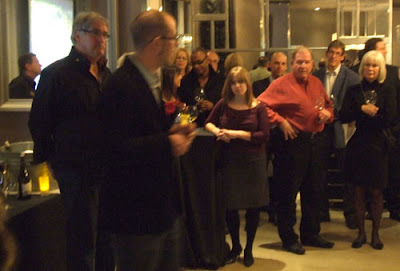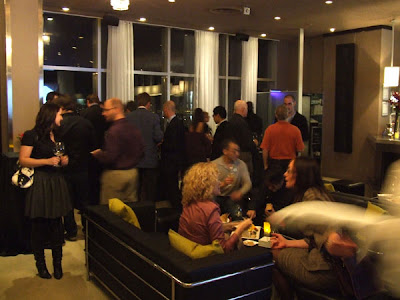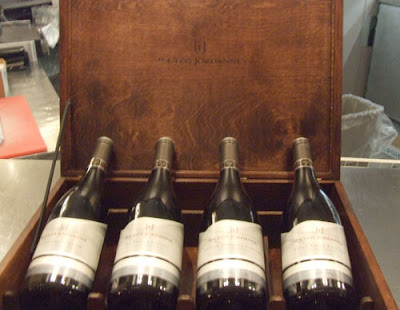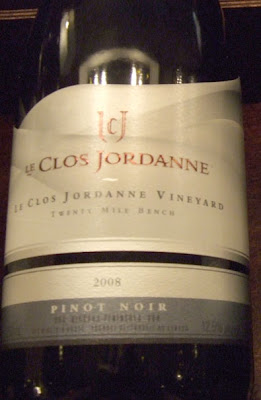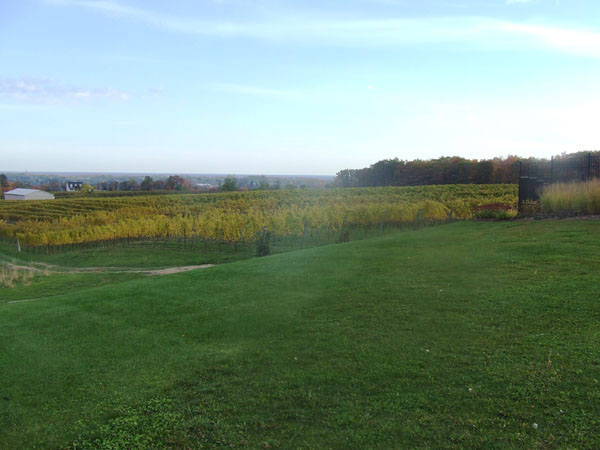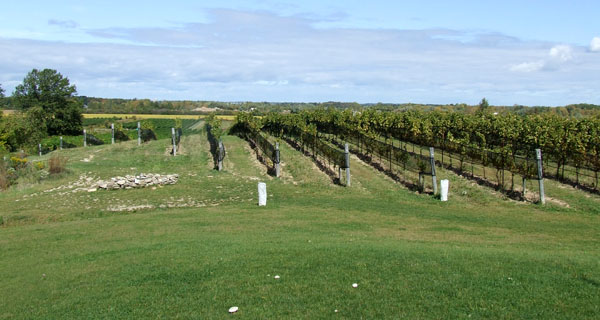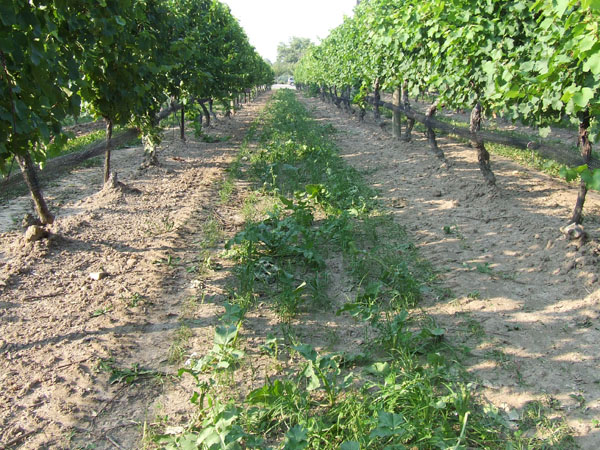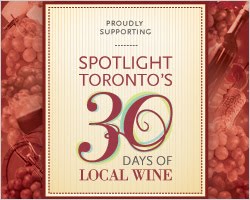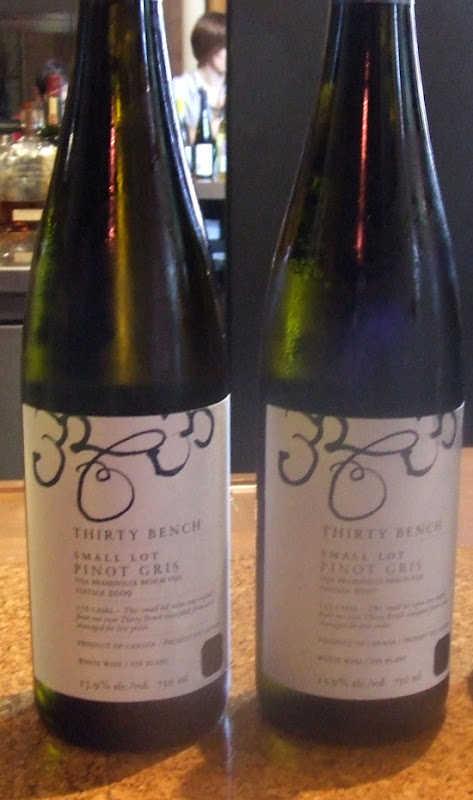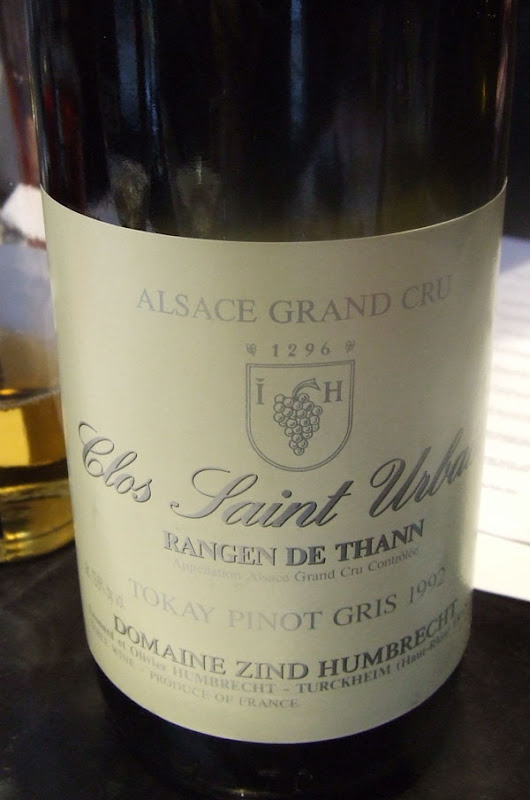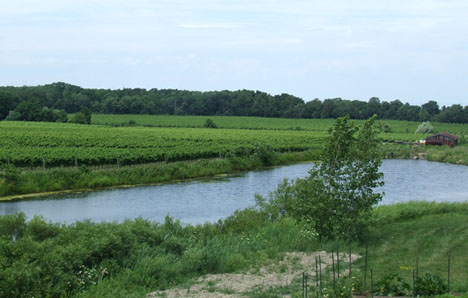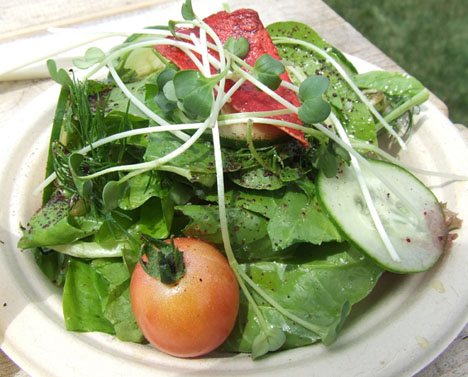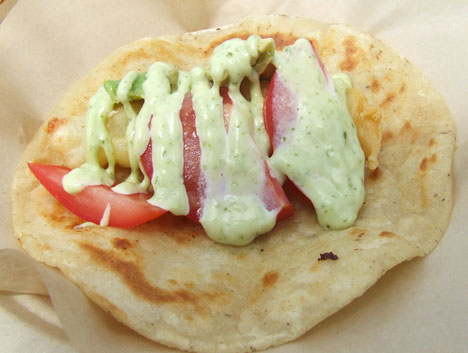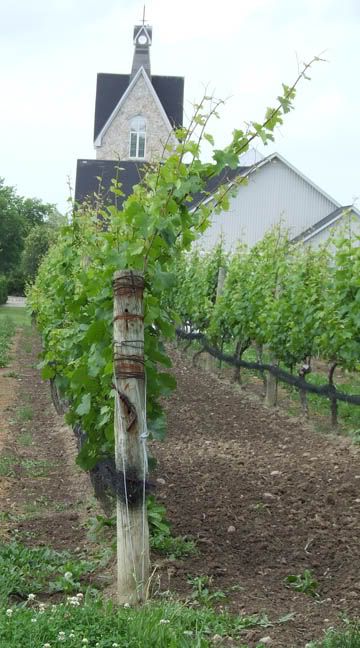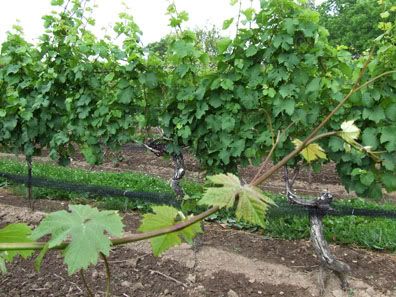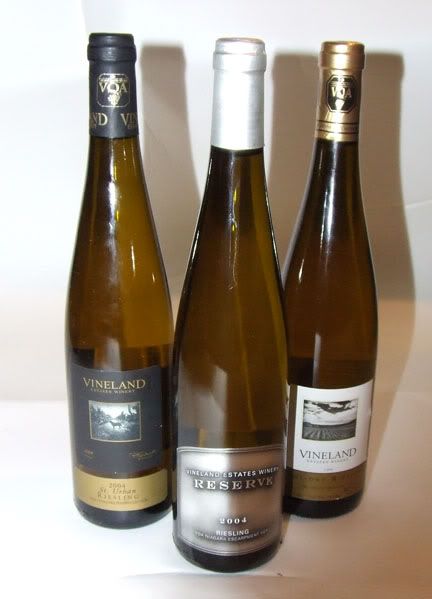Tawse Comes of Age
As Paul Pender is talking to a group of bloggers amongst the vines about the difference he's seen in Tawse's recent move toward organic and biodynamic practices you get the feeling that the near decade old winery is coming into its own under his stewardship
For Pender it really is all about what happens out in the vineyards. The few times I've spoken to him he's always been in a flannel shirt, jeans and boots amongst the vines where he passionately and eloquently explains that what is happening in the vineyard determines the quality in the bottle. Today he starts off with a quick five minute crash course in biodynamics (see my Spotlight article for more detail on the subject) for the group, which includes some unfamiliar with the concept. He touches on all the key points: the preparations, Steiner's philosophy, the integrated self-sustaining farm and all without glossing over the more controversial cosmic aspects. The key step to unlocking terroir (see this post for a more in depth look at the subject) for Pender is the soil. “You're not getting a sense of terrior when the soil is dead”, he says. Since coming aboard in 2004 Pender has worked to convert the exisitng vines over to biodynmaic farming methods. I say methods becuase having only received organic certification this year it will be another year until the wines can be biodynamically certified.
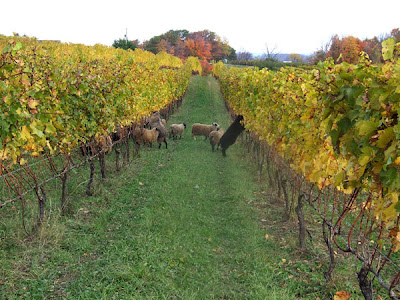 |
| From Tawse camp |
The biodynamic concept of having an integrated self-sustaining farm is something that appeals to Pender and it is something that Tawse has really begun to embrace. This year Pender has started using a horse in place of a tractor. The decrease in production (seven compared to nine acres a day) is more than a fair trade-off for less compaction of the top soil, he says. The vineyard's sheep are just tall enough to eat the leaves keeping the vine's fruiting zone exposed to the sun for ripening and good air flow. Plus they provide manure for the vineyard as they do at Southbrook. The chickens fertilise and provide pest management as they roam amongst the vines. They also provide a bonus of free-run of eggs which are sold at the winery. The small Shetland sheep go to slaughter in the fall and generally end-up on a plate at a local restaurant. But given the cost to raise them nether is a money maker for the winery. It's more about keeping with the biodynamic spirit of creating a self-sustaining integrated farm.
 |
| From Tawse camp |
Although not a required biodynamic practice clover is planted as a cover crop between the rows a—common practice in almost all of Ontario's vineyards. Cover crops are known to provide numerous benefits. Reduced soil erosion, stability for people and/or tractors between the rows (especially in wetter conditions), weed suppression, a habitat for beneficial insects, a home to discourage harmful bugs from the moving on to the vines, organic material, nitrogen and lastly soil structure improvement via drainage. But maintaining cover crops costs money and they can compete with vines for resources as well as attract pests. In Tawse's case the sheep are a solution to these issues happily keeping the cover crop and pests in check as they greedily clear whole blocks in a matter of hours.
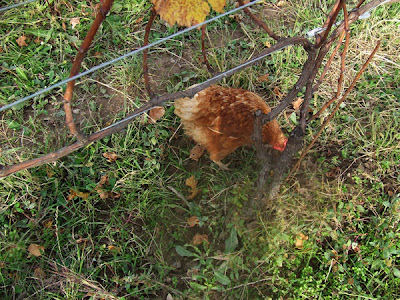 |
| From Tawse camp |
Pender believes that with its thick tap root oil seed radish (another cover crop sometimes used) can cause soil compaction. He prefers clover because in his experience the finer root system leads to better drainage. With a heavier clay soil at the home Cherry Avenue property good drainage through the top layers is key. A heavy compacted clay can have a tendency to allow water to sit near the surface and drain slowly—a problem you want to absolutely avoid if possible. Overall Pender has noticed that since implementing the biodynamic practices the health and caliber of the estate fruit has maintained top quality even in challenging vintages.
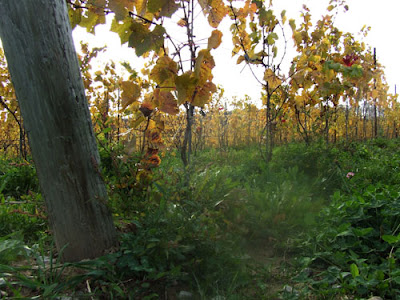 |
| From Tawse camp |
Another strategy being employed at Tawse in the pursuit of better grapes is the use of tighter spacing on the Burgundian model.
The theory is that with the vines tightly planted the root systems dig deep and fiercely compete for nutrients leading to less fruit per vine but higher yields overall per acre/hectare. Furthermore with more canopy and fewer bunches to ripen you should end-up with high-quality, small and intensely flavoured grapes that express a sense of place. Although it sounds good in theory tight planting is not a light undertaking. With the extra roots in close proximity good soil structure is essential for them to remain healthy. The tight spacing also means that good canopy management like shoot positioning and leaf stripping is essential not only for ripening but also to help with disease pressure. The Cherry Avenue vineyard seems to have good air flow which helps keep things dry and thus far it means there's not been a need for wind machines (to reduce frost risk) according to Pender. Some of the vines on Cherry Avenue are quite old for Niagara (Robyn's Block of 29-year-old Chardonnay and Carly's block of 34-year-old Riesling) so ripping out before the vines have reached the end of their life-span just to try tight planting would be a shame. Nobody is planning to rip vines out prematurely but if the trails work well and older blocks need replacing you would have to believe tighter spacing would be seriously considered. Tawse's tight planting trails use five foot row spacing (most Niagara planting is eight-nine foot between rows which fits the locally available tractors) but this requires all hand labour until a special tractor from Burgundy arrives next year.
 |
| From Tawse camp |
For Pender Niagara has reached a maturing point where the winemaking technique and knowledge is very solid, so gains to be made there aren't dramatic. With Brock's Cool Climate Oenology and Viticulture Institute approaching its 15th year and Niagara College Teaching Winery closing in on a decade of operation there is certainly a lot more people educated in winemaking and viticulture than there was in Niagara just a short decades ago. Thus it's only logical that the focus be on the vines. “The biggest advances will come from the vineyard. We need to pay attention to what the vineyards are telling us. If we don't pay attention to that we won't get anywhere,” Pender say.
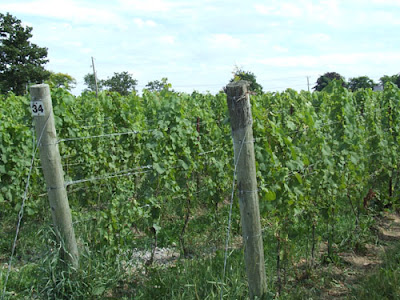 |
| From Tawse camp |
Part of that focus is growing fewer varieties. Riesling, Chardonnay, Pinot Noir and Cabernet Franc are what should be grown in Niagara according to Pender. Gamay could also work but the lower price point works against it in the business sense. Trying to grow everything and being everything to everyone doesn't work in the cool climate of Niagara according to Pender. He cites Oregon as a great example of a region that despite some recent troubles has been able to position itself as a premium region by focusing on one grape: Pinot Noir. In a bit of an ironic twist Pender has inherited a couple of mixed vineyards as Tawse begins to expand. The Hillside vineyard purchase from Lakeview Cellars last year has 23-year-old Cabernet Sauvignon vines as well as 13-year-old Pinot Gris and 11-year-old Syrah. The Thomas & Vaughn vineyard purchased late last year has the same three varieties as well as Merlot. Talking to Pender you get the feeling he's a bit conflicted growing varieties that he feels aren't suited to the climate year-in-and-out—he mentioned in passing that 2010 might but be the one year in a decade that Syrah fully ripens. At the same time ripping out 23-year-old vines when a life expectancy of 30 years is considered very good is something that pains every winemaker especially in a good vintage. It seems that right now the plan is to carefully monitor the vines. If there's damage and/or the fruit isn't up to quality the inevitable replanting will come sooner rather than later.
 |
| From Tawse camp |
What will be intriguing to watch is what these additional vineyards mean for Tawse. After starting as a small producer focusing on premium-priced Burgundian-styled Chardonnay Tawse began to branch out a bit with the Echos line primarily focused on giving the restaurant market something at a lower price point. Echos became a restaurant only line with Sketches of Niagara, which is bottled at the Hillside vineyard, being the retail/consumer version of it. After acquiring the Lakeview and Thomas and Vaughn properties plus the Quarry Road and Tintern Road vineyards Tawse's combined the potential is for about 115 acres of grapes. That production has it moving away from small producer status towards at least a large mid-sized producer. What remains to be seen is where that new grape production will go. If the fruit proves distinctive enough small batch single vineyard bottlings are a possibility. But there is a high likelihood that much of the fruit will, at least initially, end-up in the Sketches of Niagara line unless it shows the distinction to warrant a single vineyard bottling like Quarry Road began to a few years ago in 2006. Even if it does show distinction it may continue to see part of production declassified like Quarry Road because it could be too much volume for a single vineyard bottling.
 |
| From Tawse camp |
The Quarry Road vineyard is just starting to move towards full production. Located on a former Quarry site owner Moray Tawse bought it simply because he thought it would be a good investment says Pender. And Tawse would know a good real estate investment being responsible for mortgage investments at First National Financial. Being on the northern edge of the Niagara's grape growing region in the Vinemount Ridge the grapes can struggle a bit ripen in tough years, but the old adage is that the extra work pays off in the bottle. What Quarry Road gives up in some heat ripening to the Twenty Mile Bench site on Cherry Avenue, it possesses in other characteristics. It has an ideal slope, good drainage and a consistent breeze that really helps keep the vines dry in a wet season. The retired Quarry site sits on lighter soil that's rich in limestone compared to the heavier clay with moderate limestone of the home Cherry Avenue vineyard. At first Pender wasn't really convinced of the site's potential to produce quality fruit to the level of the Cherry Avenue vineyard but he says the organic and biodynamic methods have started to make a difference.
 |
| From Tawse camp |
Pender brought up the topic of clones in terroir after giving an overview of Tawse's six-level gravity-fed facility on Cherry Avenue. Harvest starts at the top of the winery where the standard premium practices of hand-sorting and destemming are done before fermentation. In some cases the wine moves into large oak fermentors before eventually moving down to the barrel cellar in the case of Chardonnays and red wines. He poured Riesling samples straight from the tank. One was from the widely established premium Weis 21B clone and the other from a less common Alsatian clone: 49. Pender has used clone 49 in the Quarry Road plantings as he prefers the flavours it achieves. Finished wines from clone 49 are more complete and complex, he says. But interestingly he has no desire to start bottling by separate clone. To him getting caught-up and focusing too much different clonal selections does a bit of a disservice to the wine. An example he cited was famed Burgundian producer Domaine de la Romanée-Conti where the highly mutative Pinot Noir grape has developed 50-60 different clones in a single vineyard. Pender's point is that when the wines of that producer are spoken of what the individual clone is bringing to that bottle is not brought-up. Rather the focus is on the impact of the terroir that the particular vineyard brings to that bottle. But as Pender says “there's not just one way to do terroir.”
 |
| From Tawse camp |
To illustrate the concept of terroir Pender lead the group through a bit of a blind tasting exercise. In Burgundian fashion we started with Pinot Noir. Both samples were 2009s. One from the Cherry Avenue vineyard and the other from Quarry Road. We were asked to guess which one was from what vineyard. We did the same with Chardonnay and finally we did it with the finished 2008 versions of Robyn's Block Chardonnay from the Cherry Avenue vineyard and the 2008 Quarry Road bottling. The differences were very apparent on my palate, especially the unfinished wines. The finished wines were a little more difficult to tell (both Chardonnays are vinified identically according to Pender). As Pender had said earlier the wines from the Cherry Avenue vineyard tend to be more masculine with the heavy clay soil over moderate limestone imparting richer complex flavors. Quarry Road on the other hand with its lighter soil rich in limestone tends to be tight and focused with strong minerality. With that in mind I was able to correctly identify the samples. The answer to the second part of the challenge which one we preferred put me in the Cherry Avenue camp. Its Pinot Noir had earthy elements that added an extra layer of complexity to the Quarry Road's fragrant cherries and minerals. With its citrus, pineapple and vanilla notes as well as a rounder-softer mouth feel, the Robyn's Block was victorious on my palate to the linear focus of the more austere minerality and razor sharp acidity of Quarry Road. Although a bit away form the terroir focus of the day an equally interesting exercise might have been to taste through a vertical of Robyn's Block. I'm confident that the variation of Niagara's different vintages would be apparent in the glass. But also the development of the vines and the different stylistic approaches of the various winemakers from the initial winemaker Deborah Paskus to Paul Pender would certainly be at least as drastic as the difference in terroir.
 |
| From Tawse camp |
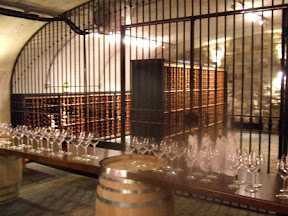 |
| From Tawse camp |
Given the theme of the day it was a curious decision for owner Moray Tawse the pour some 2005 99/1 to go with the five course lunch from The Only On King. Made from 99 percent Pinot Noir imported from nine barrels of Morey St Denis 1er Cru Burgundy and one percent Tawse Pinot Noir, the wine was protest to the 2005 rule exception when non-VQA wines were only required to have one percent Ontario grapes. The exceptionally cold winter left many vines dead or damaged from severe winter temperatures and so there was a significantly reduced crop from the vines that survived. The rule exemption was created to encourage the Ontario crop to end-up in VQA wines, but Tawse a long time critic of the blending of foreign juice and Ontario wine would have preferred the industry just made wine that year from what mother nature had given them. Tawse pulled out the Pinot Noir for lunch because he had recently tried some from the cellar and felt it was drinking very nicely. Full of rose petals, tar and earth I concur with the assessment. It was also pointed out to me by one of the other bloggers that although there is nothing wrong with selling only to the local market and tasting from it, if you don't export or taste against the rest of the world you'll never be talked about amongst the world's best. So it was certainly a treat to be able to taste a world benchmark in a 1er Cru Burgundy nearly back-to-back with some fine examples of Niagara Pinot Noir.
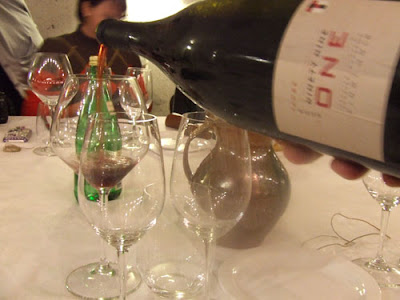 |
| From Tawse camp |
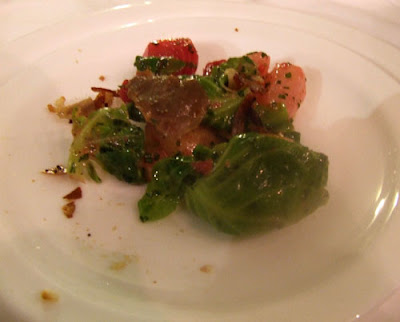 |
| From Tawse camp |
On the verge of the trip Tawse won Canadian Winery of the Year at the Canadian Wine Awards In the ten year history of the awards that honour has always gone to a B.C. winery making this win particularly special for Tawse. The Vineland winery also took White Wine of the Year for the 2008 Robyn's Block, which in another first, received the highest score ever at the awards for a table wine. Although Tawse and Robyn's Block have received recognition in the past it would seem that at least in the case of the Canadian Wine Awards the conversion to the biodynamic methods that Pender spoke about has made the difference in the judge's glasses as well. As Pender says “Terroir is a great concept. But until you can taste it's not really real.”
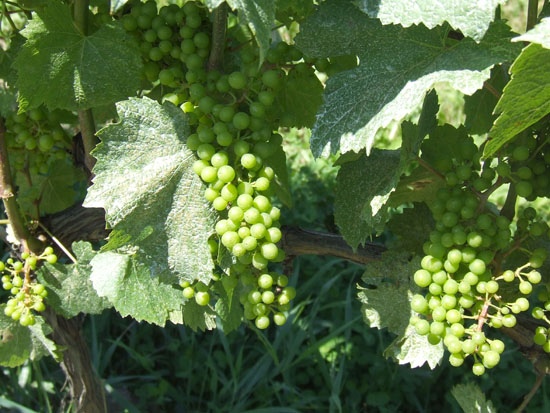 |
| From Tawse camp |

